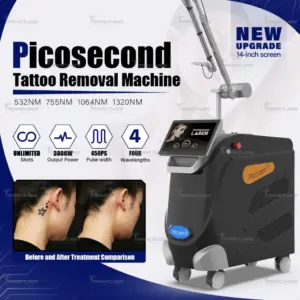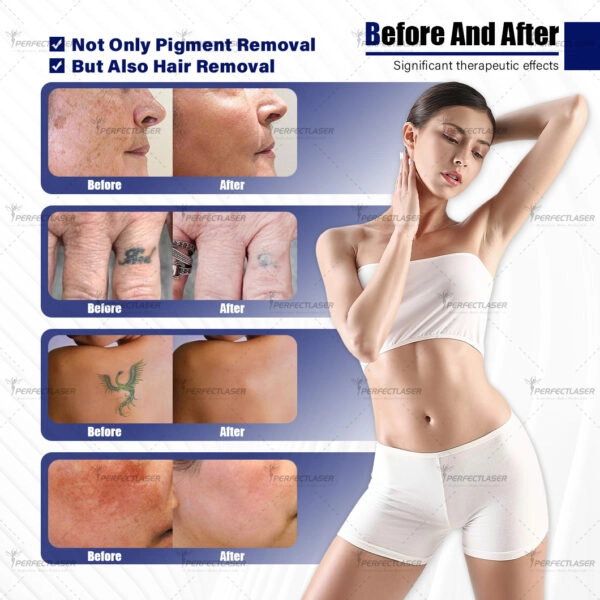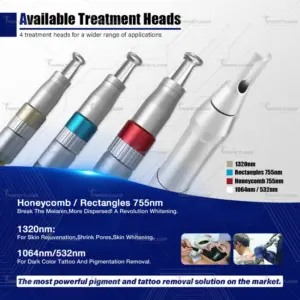
Tattoo removal has really advanced. New lasers make the process now simpler than ever. Two common choices are picosecond and Q-switch lasers. You might be thinking about removing a tattoo. Or perhaps you work in beauty or skin care. Knowing about these lasers is helpful. Understand how they work. Learn what they do. See why they’re useful.
What Are Tattoo Removal Technologies?
Tattoo removal is all about breaking up ink under the skin. Lasers are the go-to tools. They’re precise and get the job done. These lasers shoot strong beams of light. The light hits specific ink colors without hurting the skin around it. Picosecond and Q-switch lasers are the main types. Each works differently and has its own perks.
What’s a Picosecond Laser?
A picosecond laser is a newer kind of laser. It uses super quick pulses, measured in trillionths of a second. It’s built to tackle ink really well.
How Picosecond Lasers Work
Picosecond lasers fire fast bursts of energy at the tattoo. This cool tech breaks the ink into tiny bits in a split second. Your body then clears those bits away naturally. Unlike older lasers that use heat, these rely on a photoacoustic effect. That means less heat during the process. Less heat keeps nearby skin safer and cuts down on side effects.
Uses of Picosecond Lasers for Tattoos
Picosecond lasers are a breakthrough for all kinds of tattoos removal. They handle different colors and depths. They break ink into smaller pieces than older methods. This makes tattoos fade faster. They’re also good for stubborn inks that other lasers can’t touch. That makes them perfect for colorful or detailed tattoos.
Why Choose Picosecond Machines?
Picosecond machines have some big wins:
- Faster Results: They need fewer sessions. The ink breaks down better.
- Safer: They only hit the ink, not the skin around it.
- Works on Many Tattoos: They can deal with all sorts of colors and designs.
- Fewer Issues: Less heat means less chance of scars or skin color changes.
Our Picosecond Laser Tattoo Removal Machine lets you tweak settings. You can match them to the tattoo and skin type. This keeps things safe and gets the best results.
What’s a Q-Switch Laser?
Q-switch lasers have been around for a while. They’re still a solid choice for many pros in the field.
How Q-Switch Lasers Work
Q-switch lasers send out high-energy pulses in nanoseconds. These pulses heat up the ink. The heat breaks it into smaller bits. Your immune system clears those bits over time. Unlike picosecond lasers, Q-switch ones lean more on heat than photoacoustic effects.
Uses of Q-Switch Lasers for Tattoos
Q-switch lasers shine with dark tattoos, like black or dark blue ones. They’re also good for bigger tattoos. Their wider beams spread energy well. But they’re not as great with lighter or colorful tattoos. They don’t target those inks as well as picosecond lasers.
Pros and Cons of Q-Switch Lasers
Pros:
- Trusted for Years: Q-switch lasers have a long history of success.
- Cheaper: They cost less than newer tech like picosecond lasers.
- Easy to Find: Lots of clinics have them because they’ve been around.
Cons:
- Takes Longer: You might need more sessions than with picosecond lasers.
- Higher Risks: Heat can lead to scars or skin color changes.
- Not Great for All Colors: Lighter or colorful tattoos don’t fade as well.
In short, both lasers have their strengths. Picosecond lasers are super efficient with fewer side effects. Q-switch lasers are reliable for traditional needs. Knowing the differences helps you pick the right option for your tattoo.

Comparing Picosecond and Q-Switch Lasers
How Fast and Effective Are They?
The big difference is how they work. Picosecond lasers use ultra-fast pulses, in trillionths of a second. This breaks ink into tiny bits super quick. Your body clears them out faster. That means fewer trips to the clinic.
Q-switch lasers use nanosecond pulses. They work well but rely on heat. This can make the process slower. You might need more sessions to get the same results as a picosecond laser.
How They Handle Ink Colors and Skin Types
Picosecond lasers are super versatile. They tackle all kinds of tattoo colors, even tricky ones. They keep side effects low and protect the skin during and after the treatments. That makes them great for colorful or detailed tattoos. They’re also safer for darker skin tones because they’re less likely to cause scarring or color changes.
Q-switch lasers are best for dark inks, like black or dark blue. They’re not as good with lighter or colorful tattoos. Their energy spreads out more, so they might struggle with some designs or pigments.
Pain and Recovery Time
Pain depends on the laser. Picosecond lasers are gentler. Their quick pulses and low heat make sessions more comfortable. Less heat also means less redness or skin damage afterward.
Q-switch lasers use more heat. That can make sessions feel more intense. Recovery might take longer because of heat-related irritation.
How to Pick Between Picosecond and Q-Switch
Choosing the right laser depends on a few things:
- Your Tattoo: Got a colorful or detailed tattoo? Picosecond lasers are better. They handle a wide range of inks.
- Your Skin: If you have darker skin, picosecond lasers are safer. They lower the risk of skin issues.
- Your Budget: Q-switch lasers are usually cheaper. If cost matters, that might sway you.
- Your Goals: Want it done fast with fewer visits? Picosecond lasers are the way to go.
- What’s Available: Both are common, but some clinics might only offer one.
Talk to a pro before deciding. They’ll help you find the best fit.

Understanding picosecond and Q-switch lasers is key to picking the right tattoo removal method. Both can break up ink, but picosecond lasers are faster, gentler, and work on more tattoo types and skin tones. Think about your budget, tattoo details, and goals. That way, you can choose the best option for clear skin. With trusted tools from Perfectlaser, you’re on the right track.
FAQ
Q: Which laser performs better for colorful tattoos?
A: Picosecond lasers are the top choice for colorful tattoos. They handle all ink colors well. Even stubborn ones. Q-switch lasers are effective for dark inks. Like black or blue. But they have trouble with lighter inks. Or multicolored tattoos.
Q: Are picosecond lasers a safer option for darker skin tones?
A: Yes. Picosecond lasers are safer for darker skin. They generate less heat. This lowers the chance of scarring. It also reduces the chance of skin color changes. Q-switch lasers use more heat. Because of this, they can be riskier for darker skin tones.
Q: Do picosecond lasers hurt less than Q-switch lasers?
A: Usually, yes. Picosecond lasers cause less discomfort. Their super-fast pulses and lower heat make sessions gentler. Q-switch lasers depend on heat. This can feel more uncomfortable.
Q: How many sessions do I need with each laser?
A: Picosecond lasers usually need fewer sessions. They break ink into smaller bits faster. Q-switch lasers might take more visits to get the same results because they work slower.


